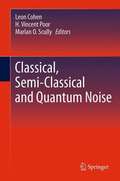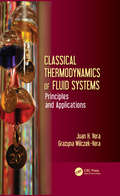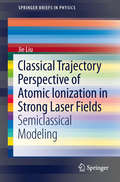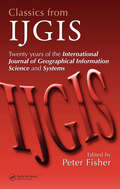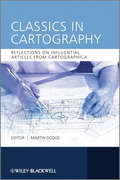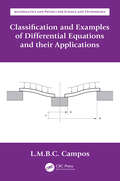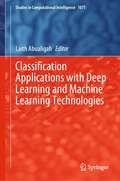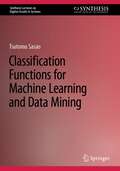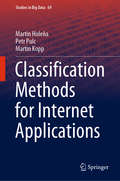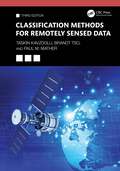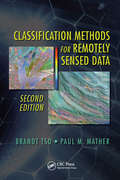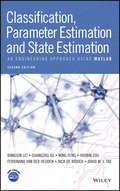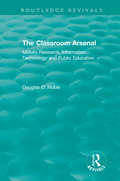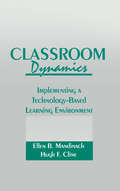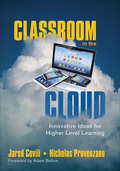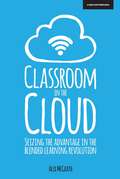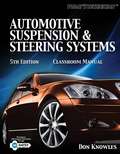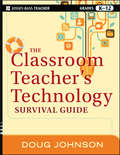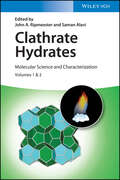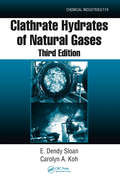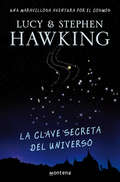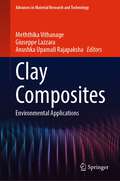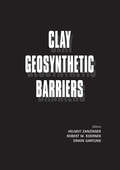- Table View
- List View
Classical, Semi-classical and Quantum Noise
by H. Vincent Poor Leon Cohen Marlan O. ScullyDavid Middleton was a towering figure of 20th Century engineering and science and one of the founders of statistical communication theory. During the second World War, the young David Middleton, working with Van Fleck, devised the notion of the matched filter, which is the most basic method used for detecting signals in noise. Over the intervening six decades, the contributions of Middleton have become classics. This collection of essays by leading scientists, engineers and colleagues of David are in his honor and reflect the wide influence that he has had on many fields. Also included is the introduction by Middleton to his forthcoming book, which gives a wonderful view of the field of communication, its history and his own views on the field that he developed over the past 60 years. Focusing on classical noise modeling and applications, Classical, Semi-Classical and Quantum Noise includes coverage of statistical communication theory, non-stationary noise, molecular footprints, noise suppression, Quantum error correction, and other related topics.
Classical Thermodynamics of Fluid Systems: Principles and Applications
by Juan H. Vera Grazyna Wilczek-VeraThis text explores the connections between different thermodynamic subjects related to fluid systems. Emphasis is placed on the clarification of concepts by returning to the conceptual foundation of thermodynamics and special effort is directed to the use of a simple nomenclature and algebra. The book presents the structural elements of classical thermodynamics of fluid systems, covers the treatment of mixtures, and shows via examples and references both the usefulness and the limitations of classical thermodynamics for the treatment of practical problems related to fluid systems. It also includes diverse selected topics of interest to researchers and advanced students and four practical appendices, including an introduction to material balances and step-by-step procedures for using the Virial EOS and the PRSV EOS for fugacities and the ASOG-KT group method for activity coefficients. The Olivera-Fuentes table of PRSV parameters for more than 800 chemical compounds and the Gmehling-Tochigi tables of ASOG interaction parameters for 43 groups are included.
Classical Trajectory Perspective of Atomic Ionization in Strong Laser Fields: Semiclassical Modeling (SpringerBriefs in Physics)
by Jie LiuThe ionization of atoms and molecules in strong laser fields is an active field in modern physics and has versatile applications in such as attosecond physics, X-ray generation, inertial confined fusion (ICF), medical science and so on. Classical Trajectory Perspective of Atomic Ionization in Strong Laser Fields covers the basic concepts in this field and discusses many interesting topics using the semiclassical model of classical trajectory ensemble simulation, which is one of the most successful ionization models and has the advantages of a clear picture, feasible computing and accounting for many exquisite experiments quantitatively. The book also presents many applications of the model in such topics as the single ionization, double ionization, neutral atom acceleration and other timely issues in strong field physics, and delivers useful messages to readers with presenting the classical trajectory perspective on the strong field atomic ionization. The book is intended for graduate students and researchers in the field of laser physics, atom molecule physics and theoretical physics. Dr. Jie Liu is a professor of Institute of Applied Physics and Computational Mathematics, China and Peking University.
Classics from IJGIS: Twenty years of the International Journal of Geographical Information Science and Systems
by Peter FisherThe past 20 years can be regarded as the adolescence of geographic information science (GIS), as it grew from a burgeoning area of study into a mature and thriving field. During those two decades, the International Journal of Geographic Information Science (formerly Systems) (IJGIS) was one of the most prominent academic guiding forces in GIScience
Classics in Cartography: Reflections on influential articles from Cartographica
by Martin DodgeClassics in Cartography provides an intellectually-driven reinterpretation of a selection of ten touchstone articles in the development of mapping scholarship over the last four decades. The ‘classics’ are drawn exclusively from the international peer-review journal Cartographica and are reprinted in full here. They are accompanied by newly commissioned reflective essays by the original article authors, and other eminent scholars, to provide fresh interpretation of the meaning of the ideas presented and their wider, lasting impact on cartographic research. The book provides an equal balance of influential articles from the past and current commentaries which highlight their impact and current context. Read in combination the original ‘classic’ articles and these new reflective essays demonstrate how cartography works as a powerful representational form and explores how various different aspects of mapping practice have been conceptualized by an influential set of academic researchers. Collates ‘classic’ articles from four decades of the journal Cartographica Brings key articles up-to-date with contemporary interpretative essays by the leading scholars in mapping research Themes covered are the epistemological of mapping practice, the ontological underpinnings of cartographic representation, and the contested societal implications of maps Evaluates the progression of the field of cartographic research and demonstrates how new theoretical ideas originate, develop and circulate Provides a signpost for students and new researchers on the key articles in cartography to read and reflect upon
Classification and Examples of Differential Equations and their Applications (Mathematics and Physics for Science and Technology)
by Luis Manuel Braga da Costa CamposClassification and Examples of Differential Equations and their Applications is the sixth book within Ordinary Differential Equations with Applications to Trajectories and Vibrations, Six-volume Set. As a set, they are the fourth volume in the series Mathematics and Physics Applied to Science and Technology. This sixth book consists of one chapter (chapter 10 of the set). It contains 20 examples related to the preceding five books and chapters 1 to 9 of the set. It includes two recollections: the first with a classification of differential equations into 500 standards and the second with a list of 500 applications. The ordinary differential equations are classified in 500 standards concerning methods of solution and related properties, including: (i) linear differential equations with constant or homogeneous coefficients and finite difference equations; (ii) linear and non-linear single differential equations and simultaneous systems; (iii) existence, unicity and other properties; (iv) derivation of general, particular, special, analytic, regular, irregular, and normal integrals; (v) linear differential equations with variable coefficients including known and new special functions. The theory of differential equations is applied to the detailed solution of 500 physical and engineering problems including: (i) one- and multidimensional oscillators, with damping or amplification, with non-resonant or resonant forcing; (ii) single, non-linear, and parametric resonance; (iii) bifurcations and chaotic dynamical systems; (iv) longitudinal and transversal deformations and buckling of bars, beams, and plates; (v) trajectories of particles; (vi) oscillations and waves in non-uniform media, ducts, and wave guides. Provides detailed solution of examples of differential equations of the types covered in tomes l-5 of the set (Ordinary Differential Equations with Applications to Trajectories and Vibrations, Six -volume Set) Includes physical and engineering problems that extend those presented in the tomes 1-6 (Ordinary Differential Equations with Applications to Trajectories and Vibrations, Six-volume Set) Includes a classification of ordinary differential equations and their properties into 500 standards that can serve as a look-up table of methods of solution Covers a recollection of 500 physical and engineering problems and sub-cases that involve the solution of differential equations Presents the problems used as examples including formulation, solution, and interpretation of results
Classification Applications with Deep Learning and Machine Learning Technologies (Studies in Computational Intelligence #1071)
by Laith AbualigahThis book is very beneficial for early researchers/faculty who want to work in deep learning and machine learning for the classification domain. It helps them study, formulate, and design their research goal by aligning the latest technologies studies’ image and data classifications. The early start-up can use it to work with product or prototype design requirement analysis and its design and development.
Classification Functions for Machine Learning and Data Mining (Synthesis Lectures on Digital Circuits & Systems)
by Tsutomu SasaoThis book introduces a novel perspective on machine learning, offering distinct advantages over neural network-based techniques. This approach boasts a reduced hardware requirement, lower power consumption, and enhanced interpretability. The applications of this approach encompass high-speed classifications, including packet classification, network intrusion detection, and exotic particle detection in high-energy physics. Moreover, it finds utility in medical diagnosis scenarios characterized by small training sets and imbalanced data. The resulting rule generated by this method can be implemented either in software or hardware. In the case of hardware implementation, circuit design can employ look-up tables (memory), rather than threshold gates.The methodology described in this book involves extracting a set of rules from a training set, composed of categorical variable vectors and their corresponding classes. Unnecessary variables are eliminated, and the rules are simplified before being transformed into a sum-of-products (SOP) form. The resulting SOP exhibits the ability to generalize and predict outputs for new inputs. The effectiveness of this approach is demonstrated through numerous examples and experimental results using the University of California-Irvine (UCI) dataset.This book is primarily intended for graduate students and researchers in the fields of logic synthesis, machine learning, and data mining. It assumes a foundational understanding of logic synthesis, while familiarity with linear algebra and statistics would be beneficial for readers.
Classification Methods for Internet Applications (Studies in Big Data #69)
by Martin Holeňa Petr Pulc Martin KoppThis book explores internet applications in which a crucial role is played by classification, such as spam filtering, recommender systems, malware detection, intrusion detection and sentiment analysis. It explains how such classification problems can be solved using various statistical and machine learning methods, including K nearest neighbours, Bayesian classifiers, the logit method, discriminant analysis, several kinds of artificial neural networks, support vector machines, classification trees and other kinds of rule-based methods, as well as random forests and other kinds of classifier ensembles. The book covers a wide range of available classification methods and their variants, not only those that have already been used in the considered kinds of applications, but also those that have the potential to be used in them in the future. The book is a valuable resource for post-graduate students and professionals alike.
Classification Methods for Remotely Sensed Data
by Paul M. Mather Taskin Kavzoglu Brandt TsoThe third edition of the bestselling Classification Methods for Remotely Sensed Data covers current state-of-the-art machine learning algorithms and developments in the analysis of remotely sensed data. This book is thoroughly updated to meet the needs of readers today and provides six new chapters on deep learning, feature extraction and selection, multisource image fusion, hyperparameter optimization, accuracy assessment with model explainability, and object-based image analysis, which is relatively a new paradigm in image processing and classification. It presents new AI-based analysis tools and metrics together with ongoing debates on accuracy assessment strategies and XAI methods.New in this edition: Provides comprehensive background on the theory of deep learning and its application to remote sensing data. Includes a chapter on hyperparameter optimization techniques to guarantee the highest performance in classification applications. Outlines the latest strategies and accuracy measures in accuracy assessment and summarizes accuracy metrics and assessment strategies. Discusses the methods used for explaining inherent structures and weighing the features of ML and AI algorithms that are critical for explaining the robustness of the models. This book is intended for industry professionals, researchers, academics, and graduate students who want a thorough and up-to-date guide to the many and varied techniques of image classification applied in the fields of geography, geospatial and earth sciences, electronic and computer science, environmental engineering, etc.
Classification Methods for Remotely Sensed Data
by Paul Mather Brandt TsoSince the publishing of the first edition of Classification Methods for Remotely Sensed Data in 2001, the field of pattern recognition has expanded in many new directions that make use of new technologies to capture data and more powerful computers to mine and process it. What seemed visionary but a decade ago is now being put to use and refined in
Classification, Parameter Estimation and State Estimation: An Engineering Approach Using MATLAB
by Yaobin Zou Ming Feng Guangzhu Xu Ferdinand van der Heijden Dick De Ridder David M. Tax Bangjun LeiA practical introduction to intelligent computer vision theory, design, implementation, and technology The past decade has witnessed epic growth in image processing and intelligent computer vision technology. Advancements in machine learning methods—especially among adaboost varieties and particle filtering methods—have made machine learning in intelligent computer vision more accurate and reliable than ever before. The need for expert coverage of the state of the art in this burgeoning field has never been greater, and this book satisfies that need. Fully updated and extensively revised, this 2nd Edition of the popular guide provides designers, data analysts, researchers and advanced post-graduates with a fundamental yet wholly practical introduction to intelligent computer vision. The authors walk you through the basics of computer vision, past and present, and they explore the more subtle intricacies of intelligent computer vision, with an emphasis on intelligent measurement systems. Using many timely, real-world examples, they explain and vividly demonstrate the latest developments in image and video processing techniques and technologies for machine learning in computer vision systems, including: PRTools5 software for MATLAB—especially the latest representation and generalization software toolbox for PRTools5 Machine learning applications for computer vision, with detailed discussions of contemporary state estimation techniques vs older content of particle filter methods The latest techniques for classification and supervised learning, with an emphasis on Neural Network, Genetic State Estimation and other particle filter and AI state estimation methods All new coverage of the Adaboost and its implementation in PRTools5. A valuable working resource for professionals and an excellent introduction for advanced-level students, this 2nd Edition features a wealth of illustrative examples, ranging from basic techniques to advanced intelligent computer vision system implementations. Additional examples and tutorials, as well as a question and solution forum, can be found on a companion website.
The Classroom Arsenal: Military Research, Information Technology and Public Education (Routledge Revivals)
by Douglas D. NobleA quarter of a century after its initial publication, The Classroom Arsenal remains pivotal in understanding and challenging the relentless promotion of technology to reform education. This seemingly benign education technology juggernaut carries forward the momentum of military agendas in man-machine systems detailed in the book. Promoters continue to flood schools with technology and its (still unfulfilled) promise of cutting edge, "personalized learning." Meanwhile, they continue as well their insatiable pursuit of federal funding, educational legitimacy, corporate profits, and access to student subjects and their accumulated learning data for product development. Less understood, though, is a companion enterprise, there from the start, to replace teaching and learning in traditional classrooms by efficient automated systems that manage and monitor human cognition and learning for high-performance systems, from weapons systems to high tech corporations. As education is moved imperceptibly away from its traditional humanistic aims and from the classroom itself, the goal of this human engineering project, the depersonalized accumulation of cognitive components for a 21st century militarized economy, best befits the book’s original title: "The Human Arsenal." This ongoing military/corporate-sponsored enterprise continues to impact education today, largely unnoticed. One example is the federally-funded Advanced Distributed Learning Initiative (ADL), which has been a major force behind the implementation of electronic learning systems, now used in all Defense Department and federal employee training. With the Defense Advanced Research Project Agency (ARPA) ADL is developing structures to capture students’ soft skills, and the Army Research Laboratory is developing "intelligent tutoring systems" to enable "instructional management of affect, engagement, and grit (perseverance)." ADL through the Department of Defense has developed Experience API, a learning technology that can monitor all student online and offline interactions and archive these in date lockers or learning record stores. ADL has already impacted thousands of school districts through nonprofits such as IMS Global and Future Ready Schools, part of an industry massively subsidized by high tech corporations and valued at $255 billion annually. A $90 million Advanced Research Projects Agency for Education (ARPA-ED), modeled after the military’s ARPA, has been proposed to fund "dramatic breakthroughs in learning and teaching." These include "digital tutors as effective as personal tutors" and, with the Navy’s Full Spectrum Learning project, "data collection tools for personalized education modeled after corporate data analysis that identifies consumer patterns and preferences." ADL is just one example of how the military/corporate ed tech enterprise is changing public education by hollowing it out into something that can be digitized, data-driven, automated, and monitored. Its promoters envision education as children interacting with online learning systems where, based on past performance, algorithms will serve up what each student needs to know next. Through this digital curriculum, students create virtual educational identities at very young ages and learning devices are watching students as much as students are watching them. Such is the education landscape presaged by The Classroom Arsenal a quarter century ago, whose origins and trajectories need to be deeply understood now more than ever.
Classroom Dynamics: Implementing a Technology-Based Learning Environment
by Ellen B. Mandinach Hugh F. ClineThis book reports an attempt to introduce change in schools using a computer-based curriculum innovation for teaching higher-order thinking skills to middle and high school students. One of the volume's themes is the extraordinary complexity and difficulty of facilitating such change in schools. A corollary of that theme is the fact that patience must be an integral part of the strategy when promoting or studying change in schools. In reporting the activities during the early years of a technological innovation and research project in which the emphasis thus far has been primarily on establishing the change, this book focuses on describing the move to a technology-based learning environment. As such, it details an ongoing process -- a fascinating process -- and one that is likely to be repeated in the near future in countless schools throughout the nation.
Classroom in the Cloud: Innovative Ideas for Higher Level Learning
by Jared Covili Nicholas ProvenzanoThe sky’s not the limit anymore—get your head in the cloud! Making the most of the digital age in education just got easier. With cloud computing, students can connect with teachers, educators can connect with colleagues, and opportunities for meaningful collaboration can grow exponentially. In this easy-to-use primer, the author of bestseller Going Google teams up with Twitter’s The Nerdy Teacher to demonstrate what cloud-based instruction can mean for teachers and students—and how it can work for your school. The book includes Practical tools for integrating cloud computing into the curriculum Student and teacher testimonies detailing examples of cloud-based instruction in action Chapters on storing, communicating, sharing, and creating Strategies for ensuring safety and security for students and information "This book provides direct quotes from teachers and students about amazing cloud-based applications. You’ll find innovative tools and practices, step-by-step instructions for implementation, and an array of tools for all grade levels and subjects. The classroom may now be in the cloud, but this book will be at my side anytime I need tech tools that are creative, easy-to-use, and fun for teaching and learning." Mark Barnes, Author of Teaching the iStudent and 5 Skills for the Global Learner "It’s more important today than ever before for educators to look beyond the walls of classrooms and connect with other colleagues in their buildings and across the globe. This book will equip all educators with the tools necessary to find the best tools to enhance and improve their teaching practices." Steven Anderson, Author, The Relevant Educator and Content Curation, @web20classroom
Classroom in the Cloud: Innovative Ideas for Higher Level Learning
by Jared Covili Nicholas ProvenzanoThe sky’s not the limit anymore—get your head in the cloud! Making the most of the digital age in education just got easier. With cloud computing, students can connect with teachers, educators can connect with colleagues, and opportunities for meaningful collaboration can grow exponentially. In this easy-to-use primer, the author of bestseller Going Google teams up with Twitter’s The Nerdy Teacher to demonstrate what cloud-based instruction can mean for teachers and students—and how it can work for your school. The book includes Practical tools for integrating cloud computing into the curriculum Student and teacher testimonies detailing examples of cloud-based instruction in action Chapters on storing, communicating, sharing, and creating Strategies for ensuring safety and security for students and information "This book provides direct quotes from teachers and students about amazing cloud-based applications. You’ll find innovative tools and practices, step-by-step instructions for implementation, and an array of tools for all grade levels and subjects. The classroom may now be in the cloud, but this book will be at my side anytime I need tech tools that are creative, easy-to-use, and fun for teaching and learning." Mark Barnes, Author of Teaching the iStudent and 5 Skills for the Global Learner "It’s more important today than ever before for educators to look beyond the walls of classrooms and connect with other colleagues in their buildings and across the globe. This book will equip all educators with the tools necessary to find the best tools to enhance and improve their teaching practices." Steven Anderson, Author, The Relevant Educator and Content Curation, @web20classroom
Classroom in the Cloud: Seizing The Advantage In The Blended Learning Revolution
by Alex McGrathThis book aims to focus the minds of teachers and school leaders to take advantage of the opportunities presented by the online revolution and the emergence of blended learning. The author, who is Head of King's Ely Senior, argues that with planning and co-ordination, huge benefits can be reaped from new ways of learning, complementing the traditions of British education. He looks at the implications for the UK of e-learning practices and techniques that have been introduced overseas and urges teachers and leaders to face the challenges posed by new technology and embrace change.
Classroom in the Cloud: Seizing The Advantage In The Blended Learning Revolution
by Alex McGrathThis book aims to focus the minds of teachers and school leaders to take advantage of the opportunities presented by the online revolution and the emergence of blended learning. The author, who is Head of King's Ely Senior, argues that with planning and co-ordination, huge benefits can be reaped from new ways of learning, complementing the traditions of British education. He looks at the implications for the UK of e-learning practices and techniques that have been introduced overseas and urges teachers and leaders to face the challenges posed by new technology and embrace change.
The Classroom Teacher'S Technology Survival Guide
by Doug JohnsonA comprehensive guide for integrating educational technology in the K-12 classroom This is a must-have resource for all K-12 teachers and administrators who want to really make the best use of available technologies. Written by Doug Johnson, an expert in educational technology, The Classroom Teacher's Technology Survival Guide is replete with practical tips teachers can easily use to engage their students and make their classrooms places where both students and teachers will enjoy learning. Covers the most up-to-date technologies and how they can best be used in the classroom Includes advice on upgrading time-tested educational strategies using technology Talks about managing "disruptive technologies" in the classroom Includes a wealth of illustrative examples, helpful suggestions, and practical tips This timely book provides a commonsense approach to choosing and using educational technology to enhance learning.
Clathrate Hydrates: Molecular Science and Characterization
by Saman Alavi John A RipmeesterClathrate Hydrates All-inclusive reference on clathrate hydrates from a molecular perspective Clathrate hydrates are crystalline water-based inclusion compounds many of which form at high pressures and low temperatures. Molecular science has provided the foundation for many areas of modern hydrate research and applications ranging from desalination processes to flow assurance in oil and gas pipelines. Clathrate Hydrates provides detailed information on the molecular science aspects of hydrate research, covering the structural, compositional, spectroscopic, thermodynamic, and mechanical properties of clathrate hydrates as well as simulation methods and selected engineering applications. Edited and authored by recognized leaders in the field, this comprehensive resource introduces readers to clathrate hydrates and reviews the state-of-the-art of the field. In-depth chapters address different areas of specialization such as characterization of clathrate hydrates using NMR spectroscopy, infrared and Raman spectroscopy, and X-ray and neutron diffraction and scattering. Highlights recent developments in clathrate hydrate research and applications such as natural gas recovery, desalination, and gas separation Reviews various molecular simulation methods for characterizing clathrate hydrates, including quantum mechanical calculations and Monte Carlo results Contains tables of known guest molecules, summaries of structural and physical properties, and different classes of clathrate hydrate phase equilibria Introduces unconventional guest-host interactions, related non-hydrate clathrates, and space-filling cages using the Frank-Kasper approach Covers the molecular motion of guest and host molecules and the relationship between cage geometry and guest dynamics Presents the rate and mechanisms of hydrate formation and decomposition from both macroscopic and microscopic points Clathrate Hydrates: Molecular Science and Characterization is an indispensable reference for materials scientists, physical chemists, chemical engineers, geochemists, and graduate students in relevant areas of science and engineering.
Clathrate Hydrates of Natural Gases (Chemical Industries)
by E. Dendy Sloan Jr. Carolyn A. KohHydrate research has expanded substantially over the past decade, resulting in more than 4,000 hydrate-related publications. Collating this vast amount of information into one source, Clathrate Hydrates of Natural Gases, Third Edition presents a thoroughly updated, authoritative, and comprehensive description of all major aspects of natural gas cla
La clave secreta del universo: Una maravillosa aventura por el cosmos (La clave secreta del universo #Volumen 1)
by Lucy HawkingCon La clave secreta del Universo el genial Stephen Hawking y su hija Lucy han conseguido acercar a los pequeños -y no tan pequeños- las maravillas y los secretos del Universo, y demostrarnos que la ciencia también puede ser divertida y apasionante. A George nada le gusta más en el mundo que mirar las estrellas; también le encantaría tener un ordenador con el que navegar y conocer más sobre el Universo, pero sabe que eso es misión imposible. En casa, sus padres son tan ecologistas que no quieren ni oír hablar del progreso y la ciencia. Pero lo que ellos no saben es que el enemigo está muy cerca. Acaba de llegar un nuevo vecino que, ¡horror!, es un eminente científico, y eso, para los padres de George, solo significa una cosa: peligro. Si hubieran imaginado lo que le esperaba a su hijo, nunca le habrían dejado entrar en su casa... Reseña:«Se juntan el asombro de un niño con la agudeza intelectual de un genio.»The Sunday Times
Clay Composites: Environmental Applications (Advances in Material Research and Technology)
by Meththika Vithanage Giuseppe Lazzara Anushka Upamali RajapakshaThis book describes the advantages and disadvantages and characterization techniques of clay-composites for environmental applications. It examines the structure and chemistry of different types of clay-composites and their synthesis, characteristics and applications in detail with a special focus on upscaling and limitations. Various topics covered in this book include overview of clay composites and their environmental applications, clay-biochar composites, clay-surfactants composites, organo-clay composites, clay hybrids and enriched clay composites. This book will be useful for beginners, researchers, material scientists and engineers who are interested in applied research of clay-based composites.
Clay Geosynthetic Barriers
by R. M. Koerner H. Zanzinger E. GartungClay geosynthetic barriers are most frequently used in environmental areas, such as landfill cover systems. This work discusses the durability and lifetime aspects of clay geosynthetic barriers related to the synthetic yarns and fibres.
